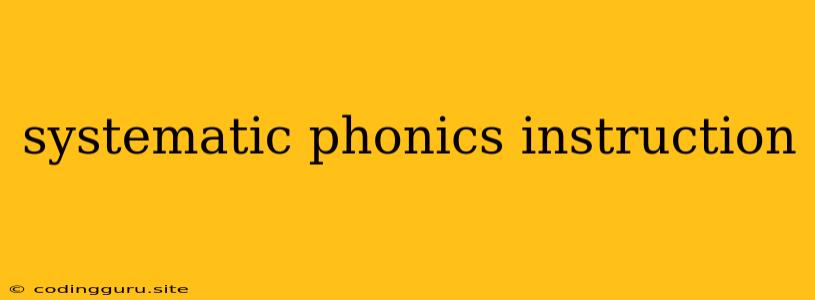What is Systematic Phonics Instruction?
Systematic phonics instruction is a method of teaching reading that focuses on the relationship between letters and sounds. It is a structured and sequential approach that helps children learn to decode words and build fluency. Instead of just memorizing words, this method teaches children the foundational skills they need to read independently.
Why is Systematic Phonics Instruction Important?
Reading is a foundational skill for success in all areas of life. Children who struggle with reading often have difficulty in school and may even experience social and emotional challenges. Systematic phonics instruction is crucial because it:
- Provides a strong foundation for reading: It teaches children the building blocks of reading, allowing them to decode words and understand how language works.
- Improves reading fluency and comprehension: As children become more confident in their decoding skills, they can read more smoothly and understand what they are reading.
- Helps children become independent readers: Systematic phonics instruction equips children with the tools they need to read independently, opening doors to a world of knowledge and enjoyment.
How Does Systematic Phonics Instruction Work?
Systematic phonics instruction follows a specific sequence, starting with the most basic sounds and gradually introducing more complex concepts. Here's a general outline:
1. Phonemic Awareness: This stage focuses on developing awareness of individual sounds in spoken words. Activities may include: * Rhyming games: Identifying words that rhyme. * Sound isolation: Identifying the initial, medial, and final sounds in a word. * Blending and segmenting: Combining individual sounds to form a word or separating a word into its individual sounds.
2. Letter-Sound Correspondence: This stage introduces the relationship between letters and their corresponding sounds. Children learn to identify the sounds each letter represents.
3. Blending and Segmenting: Children learn to blend sounds together to form words and to segment words into their individual sounds.
4. Decoding Words: This stage combines the skills learned in previous stages to enable children to read simple words. They begin to decode words by breaking them down into individual sounds and blending them together.
5. Sight Words: These are high-frequency words that children often encounter but cannot be easily decoded using phonics rules. Sight words are memorized and recognized instantly.
6. Fluency and Comprehension: As children become more fluent in decoding, they can focus on understanding the meaning of the text. Activities may include: * Repeated readings: Reading the same text multiple times to improve fluency. * Comprehension questions: Answering questions about the text to demonstrate understanding.
Tips for Implementing Systematic Phonics Instruction:
- Start early: The earlier children are introduced to phonics instruction, the better.
- Be consistent: Practice phonics skills regularly and reinforce them in all aspects of reading.
- Make it fun: Use engaging activities and games to keep children motivated.
- Use multisensory approaches: Incorporate visual, auditory, and kinesthetic activities to cater to different learning styles.
- Individualize instruction: Adapt the pace and level of instruction to meet the needs of each child.
Examples of Systematic Phonics Instruction:
Many different programs and resources are available for systematic phonics instruction. Here are a few examples:
- Jolly Phonics: A popular program that uses multisensory methods and engaging activities.
- Sounds Right: A program designed to teach phonics in a structured and systematic way.
- Phonics Pathways: A comprehensive phonics program that covers all the essential skills.
Conclusion
Systematic phonics instruction is an essential tool for teaching children to read. By providing a strong foundation in decoding and fluency, it helps children become confident, independent readers. Parents, teachers, and anyone involved in a child's education can benefit from understanding and implementing the principles of systematic phonics.
